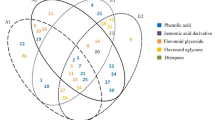Abstract
Leaves and fruits of Murta (Ugni Molinae Turcz.) growing in three locations of Chile with diverse climatic conditions were extracted by using ethanol/water mixtures at different ratios and the antimicrobial activity was assessed. Extracts containing the highest polyphenolic content were from murta plants grown nearer to the mountain (58 mg GAE/g murta), subjected to extreme summer/winter-day/night temperature changes and rainy regime. Extracts from leaves collected in the valley and coast contained 46 and 40 mg GAE/g murta, respectively. A mixture of 50% ethanol/water was the most efficient in extracting polyphenols, showing pure solvents—both water and ethanol—a lower extraction capacity. No correlation between antioxidant capacity and polyphenolic content was found. Extracts from Murta leaves provoked a decrease in the growing of Pseudomonas aeruginosa, Klebsiella pneumoniae and Staphylococcus aureus, and showed no activity against the beneficial, probiotic bacteria. A significant correlation between polyphenol content and antimicrobial activity on harmful bacteria was found. Myricetin glucoside and quercetin glucoside/glucuronide/dirhamnoside presumably contributed to the antimicrobial activity of the extract. The higher antimicrobial activity of leaves extracts compared to the fruits could be attributed to flavan-3-ols and other flavonol glycosides. Quercetin glucuronide, myricetin xyloside and flavan-3-ols in polymeric form were tentatively identified for the first time in murta extracts. Both extracts showed an antimicrobial activity similar to some commercial antibiotics, suggesting their suitability to replace synthetic antimicrobials in food.


Similar content being viewed by others
References
Montenegro G (2000) In Chile Nuestra Flora útil. Guía de plantas de uso apícola en medicina folclórica artesanal. Universidad Católica de Chile, Santiago de Chile, pp 241–242
Aguirre M, Delporte C, Backhouse N, Erazo S, Letelier M, Cassels B, Silva X, Alegría S, Negrete R (2006) Topical anti-inflammatory activity of 2a-hydroxy pentacyclic triterpene acids from the leaves of Ugni molinae. Bioorg Med Chem 14:5673–5677
Rubilar M, Pinelo M, Ihl M, Scheuermann E, Sineiro J, Núñez MJ (2006) Murta leaves (Ugni molinae Turcz) as a source of antioxidant polyphenols. J Agric Food Chem 54:59–64
Delporte C, Backhouse N, Inostroza V (2007) Analgesic activity of Ugni molinae (murtilla) in mice models of acute pain. J Ethnopharmacol 112:162–165
Suwalsky M, Orellana P, Avello M (2007) Ugni mulinae Turcz against oxidative damage of human erythrocytes. Food Chem Toxicol 45:130–135
Microbiological consideration for antimicrobial food additives submission. US Food and Drug administration (http://www.cfsan.fda.gov/~dms/antguid.html#C). Accessed on 10 December 2007
Fattouch S, Caboni P, Coroneo V, Tuberoso CI, Angioni A, Dessi S, Marzouki N, Cabras P (2007) Biological Antimicrobial activity of Tunisian quince (Cydonia oblonga Miller) pulp and peel polyphenolic extracts. J Agric Food Chem 55:963–969
Pepeljnjak S, Kalodera Z, Zovko M (2005) Antimicrobial activity of flavonoids from Pelargonium radula (Cav.) L’Hérit. Acta Pharm 55:431–435
Kosalec I, Pepeljnjak S, Bakmaz M, Vladimir-Knezević S (2005) Flavonoid analysis and antimicrobial activity of commercially available propolis products. Acta Pharm 55:423–430
Robbins RJ, Keck AS, Banuelos G, Finley JW (2005) Cultivation conditions and selenium fertilization alter the phenolic profile, glucosinolate, and sulforaphane content of broccoli. J Med Food 8:204–214
Pinelo M, Arnous A, Meyer AS (2006) Upgrading of grape skins: significance of plant cell-wall structural components and extraction techniques for phenol release. Trends Food Sci Technol 17:579–590
Pinelo M, Sineiro J, Nuñez MJ (2006) Mass transfer during continuous solid-liquid extraction of antioxidants from grape byproducts. J Food Eng 77:57–63
Singleton VL, Rossi JA (1965) Colorimetry of total phenols with phosphomolybdic-phosphotungstic acid reagents. Am J Enol Vitic 16:144–158
Velioglu YS, Mazza G, Gao L, Oomah BD (2006) Antioxidant activity and total phenolics in selected fruits, vegetables, and grain products. J Agric Food Chem 46:4113–4117
Rubilar M, Pinelo M, Shene C, Sineiro J, Núñez MJ (2007) Separation and HPLC-MS identification of phenolic antioxidants from agricultural residues: almond hulls and grape pomace. J Agric Food Chem 55:10101–10109
Bergonzi MC, Bilia AR, Bari L, Mazzi G, Vincieri FF (2007) Studies on the interactions between some flavonols and cyclodextrins. Bioorg Med Chem Lett 17:5744–5748
Amsellem L, McKey DB (2006) Integrating phenological, chemical and biotic defenses in ant-plant protection mutualisms: a case study of two myrmecophyte lineages. Chemoecology 16:223–234
Anas K, Jayasree PR, Vijayakumar T, Kumar PRM (2008) In vitro antibacterial activity of Psidium guajava Linn. Leaf extract on clinical isolates of multidrug resistant Staphylococcus aureus. Ind J Exp Biol 46:41–46
Igbeneghu OA, Iwalewa EO, Lamikanra A (2007) A study of the in vivo activity of the leaf extract of Alchornea cordifolia against multiply antibiotic resistant S. aureus isolate in mice. Phytother Res 21:67–71
Silber ML, Davitt BB, Khairutdinov RF, Hurst JK (1998) A mathematical model describing tannin–protein association. Anal Biochem 263:46–50
Mandalari G, Bennett RN, Bisignano G, Trombetta D, Saija A, Faulds CB, Gasson MJ, Narbad A (2007) Antimicrobial activity of flavonoids extracted from bergamot (Citrus bergamia Risso) peel, a byproduct of the essential oil industry. J Appl Microbiol 103:2056–2064
Rauha JP, Remes S, Heinonen M, Hopia A, Kahkonen M, Kujala T, Pihlaja K, Vuorela H, Vuorela P (2000) Antimicrobial effects of Finnish plant extracts containing flavonoids and other phenolic compounds. Int J Food Microbiol 56:3–12
Arima H, Ashida H, Danno G (2002) Rutin-enhanced antibacterial activities of flavonoids against Bacillus cereus and Salmonella enteritidis Biosci. Biotechnol Biochem 66:1009–1014
Rubilar M, Pinelo M, Franco D, Sineiro J, Núñez MJ (2003) Agroindustrial residues as a source of antioxidants. Afinidad 60:153–160
Acknowledgments
Authors acknowledge the financial support given by Conicyt through Fondecyt project 1060311 and technical support provided by Dirección de Investigación at Universidad de La Frontera.
Author information
Authors and Affiliations
Corresponding author
Rights and permissions
About this article
Cite this article
Shene, C., Reyes, A.K., Villarroel, M. et al. Plant location and extraction procedure strongly alter the antimicrobial activity of murta extracts. Eur Food Res Technol 228, 467–475 (2009). https://doi.org/10.1007/s00217-008-0954-3
Received:
Revised:
Accepted:
Published:
Issue Date:
DOI: https://doi.org/10.1007/s00217-008-0954-3




